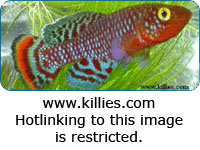|
Killifish, or killies for short, belong to the order Cyprinodontiformes or egg laying toothcarps. The name "killi" is derived from the Dutch word meaning "creek". Killies, in other words, are "fish from the creek". But the name is a misnomer as killies, which can be found in almost every part of the world, also live in ponds, streams, rivers, bays and estauries, basically, whereever there is water and sometimes even when there is none. The real reason these fish are known as killies is because their names can really kill; trying to remember them is pure murder. Just kidding of course, but killie names can be quite a mouthful sometimes. Just try saying "Simpsonichthys" or "albimarginatus" and you will know what I mean. There is a good reason, however, why killies do not usually have common names. Using scientific names is the only way to keep track of lineage and identity. Thanks to the conscientiousness and efforts of killie breeders worldwide, most killie species have been kept pure. Unlike almost all other tropical fish which have been cross-bred to death, there is no "Jin Gang Killie" or a "Half Moon Killie". So never cross your killies. If you do, don't ever distribute the hybrids and don't ever, ever sell the eggs. |
|
|
Broadly speaking, killies can be divided into 2 categories, the Non-annuals and the Annuals. Supposedly, Non-annuals prefer soft acidic water while Annuals will only thrive in hard alkaline water. But let me tell you a little secret - Other than adding salt into breeding tanks, I don't do anything to change the water chemistry in my killie tanks. In other words, all my killies live in waters of Ph 7 and Kh 0. They also say killies will only breed in low temperatures, something like 25 degrees centigrade. I don't have air-conditioning and I can't afford chillers, so the temperatures in all my tanks are about 30 degrees centigrade most of the time, sometimes even higher. I have not bred every one of my killies yet but I have succeeded with quite a few.
|
|
|
Non-annuals would include killies like the Aphyosemions. If you should come across a killie in one of Singapore's fish shop, chances are it is an Aphyosemion australe, one of the few killies to have a common name, the Lyretail. The Non-annuals lay their eggs on aquatic plants or spawning mops. It is highly unlikely though, that you will ever come across a female Lyretail here. Many local fish shop owners and importers foolishly believe that if they sell the females, hobbyists like you and me will get to breed the fish and undercut their market. Heck, there is no point keeping the fish if you cannot breed them. |
|
|
Annuals, as the name suggests, are killies that usually would not live longer than a year or so. They come from countries with distinct wet and dry seasons. One of the most beautiful of all Annuals is the Nothobranchius rachovii. Nothos, as they are often called, comes mainly from Africa. When the rainy season is over and the ponds dry up, the fish die but their eggs will be waiting in the mud for the next monsoon season. When the rains fall and the pond fills up, the eggs hatch and the Nothobranchius live again. |
|
|
For more information about killies and their amazing life cycles, visit the AKA (American Killifish Association) website at: http://www.aka.org Loh
Kwek Leong |
|
